LED lighting safety is crucial for optimal use. It is important to check outdoor ratings for water exposure, use suitable cords and bulbs outdoors, secure cord placement, and protect outlets with GFCI. To prevent fires, keep LED lights away from flammable materials. Ensure wattage is evenly distributed across circuits and adhere to weight guidelines for hanging fixtures. Avoiding water exposure is critical as it can pose significant risks. By following these tips, you can ensure the efficient use of LED lighting.
Key Takeaways
- Use outdoor-rated LED lights for proper weather resistance.
- Avoid overloading circuits by distributing LED lights effectively.
- Secure cords to prevent tripping hazards and damage.
- Regularly inspect LED lights for signs of wear or damage.
- Follow manufacturer guidelines for safe installation and weight limits.
Outdoor Use LED Lights Ratings
Outdoor LED lights are categorized into dry, damp, or wet ratings by Underwriters Laboratories for different levels of outdoor exposure. When it comes to outdoor lighting, it's important to understand these ratings to guarantee safety and longevity of the fixtures.
LED lights are safe options for outdoor use, but using the correct rating is vital for peak performance. Damp-rated LED lights can withstand indirect water exposure, making them suitable for areas where they might encounter moisture, such as covered patios. On the other hand, wet-rated LED lights are designed to handle direct water exposure, making them ideal for outdoor spaces where they might come into contact with rain or snow.
It's important to note that LED lights without specific ratings aren't recommended for wet outdoor conditions to prevent damage and ensure safety. By following these safety tips and using the appropriate outdoor-rated LED lights, individuals can illuminate their outdoor spaces effectively and safely.
Outdoor-rated Extension Cords and Bulbs
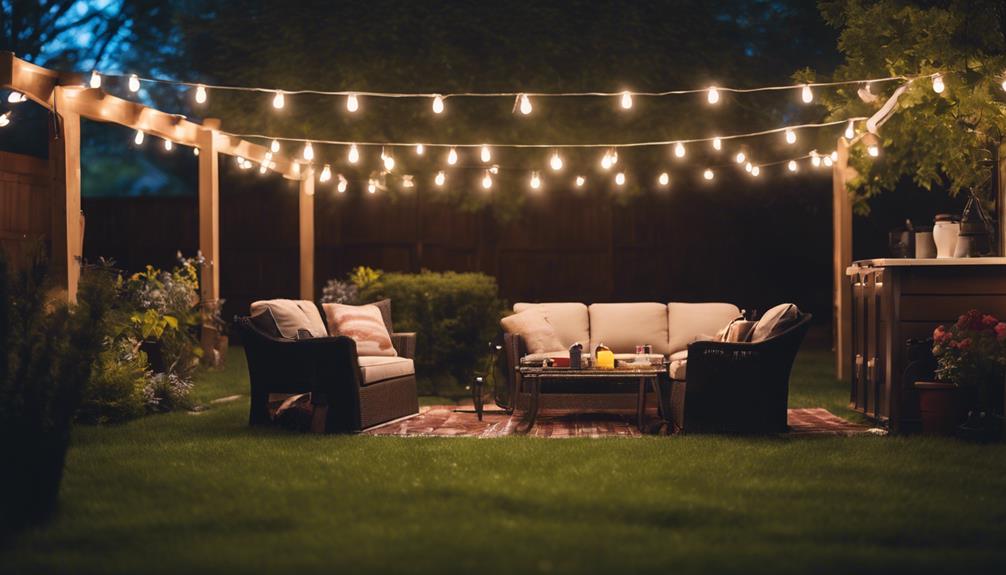
Outdoor-rated extension cords and bulbs are essential for outdoor lighting setups due to their ability to withstand moisture and temperature changes. Using non-outdoor-rated components can lead to safety hazards and electrical malfunctions.
Ensuring weatherproofing and proper wattage compatibility are vital for the longevity and safety of your outdoor lighting system.
Weatherproofing for Longevity
How can weatherproofing with the right extension cords and bulbs enhance the longevity of your LED string lights? Outdoor-rated extension cords and bulbs are essential for safeguarding LED string lights from weather elements like rain and snow. Using non-outdoor-rated components can pose electrical hazards and lead to premature light failure. Weatherproofing not only guarantees the longevity of outdoor LED lighting setups but also maintains their functionality and aesthetic appeal. Investing in outdoor-rated accessories is a wise choice to avoid risks and ensure durable outdoor lighting solutions. Below is a table summarizing the importance of weatherproofing with outdoor-rated extension cords and bulbs for LED lights:
| Aspect | Importance |
|---|---|
| Safety | Protects from electrical hazards |
| Longevity | Ensures durability of lights |
| Functionality | Maintains performance |
| Aesthetic Appeal | Preserves the look of the lights |
| Reliability | Prevents premature light failure |
Proper Wattage Compatibility
Using LED lights with suitable wattage compatibility is vital to prevent overheating and electrical issues in outdoor settings. When utilizing outdoor-rated extension cords and bulbs, it's important to verify that the wattage of the LED bulbs matches the fixture's specifications.
This practice not only helps in avoiding damage and safety hazards but also reduces the risk of fire hazards. Proper wattage compatibility plays a significant role in ensuring efficient LED light operation while preventing issues like flickering and premature failure.
Cord Placement and Installation

When installing LED lighting, make sure cords are positioned away from high-traffic areas to prevent tripping hazards. Utilize cord covers or tape to secure cords along walls or baseboards, keeping them out of the way. Avoid running cords under rugs or furniture where they can get damaged or create a fire hazard.
Here are some essential tips for cord placement and installation:
- Secure Cords Safely: Use cord covers or tape to keep cords tidy and prevent them from becoming tripping hazards.
- Prevent Damage: Ensure cords aren't pinched or twisted to prevent damage that could lead to safety hazards.
- Use the Right Extension Cords: Choose extension cords rated for either outdoor or indoor use based on the specific installation location to maintain safety and proper functioning.
Following these guidelines will help maintain a safe environment when using LED bulbs, especially in areas like garage lighting where cords are commonly utilized.
Plug Protection and GFCI Outlets
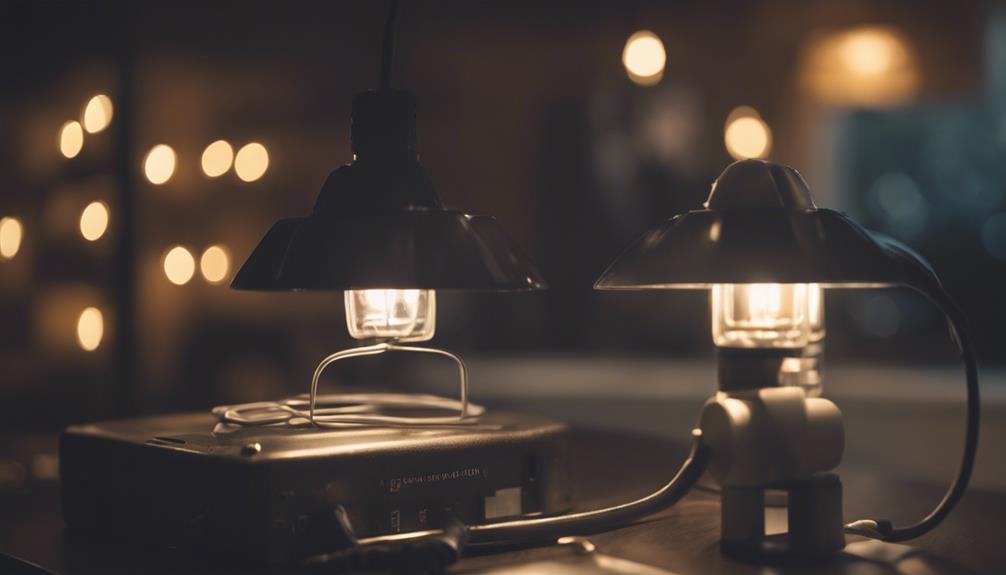
To enhance electrical safety at home, practical measures can be taken to safeguard outlets and prevent potential hazards. One important step is to use plug protectors to cover unused outlets when using LED lighting fixtures. These protectors help prevent accidental electric shocks, especially in households with children.
Additionally, incorporating Ground Fault Circuit Interrupter (GFCI) outlets is vital for safety. GFCI outlets automatically cut off power in the event of an electrical fault, reducing the risk of electric shock accidents. They are particularly essential in areas with water exposure like kitchens and bathrooms.
Regularly testing GFCI outlets is recommended to ensure they are functioning correctly and providing maximum safety. By implementing these measures, the potential for electric shock incidents can be greatly reduced, promoting a safer environment when using LED lighting in your home.
Avoid Flammable Exposure
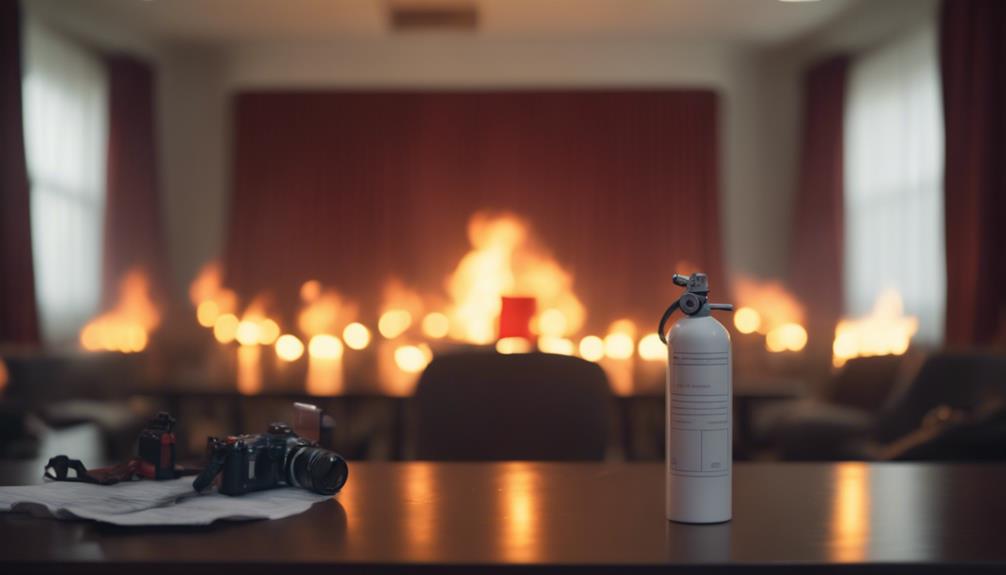
LED lights can pose a fire hazard if they come into contact with flammable materials such as curtains or paper. To prevent potential accidents, it's important to keep LED lights away from any flammable substances.
Keep Lights Away
Placing LED lights near flammable materials poses a significant fire hazard due to their potential to overheat. To prevent fire hazards, it's important to keep LED lights away from items such as curtains, paper, fabrics, aerosol cans, cleaning agents, or any combustible materials.
Here are three essential tips to maintain safety when using LED lights:
- Avoid flammable exposure: Keep LED lights away from curtains, paper, fabrics, or any other flammable items.
- Watch out for combustible materials: Make sure LED lights aren't near aerosol cans, cleaning agents, or any other combustible substances.
- Maintain proper ventilation: Ensure there's adequate airflow around LED lights to prevent heat buildup and reduce fire risks.
Use in Dry Areas
When using LED lights in dry areas, be mindful to avoid exposing them to flammable materials. LED lights are important as they don't emit heat that can ignite flammable substances, reducing fire hazards.
To prevent accidents, avoid placing LED lights near curtains, paper, or any other flammable items. The cool-to-the-touch nature of LED lights also minimizes the risk of accidental burns or fires.
Proper ventilation around LED lights is essential to prevent heat buildup in enclosed spaces. It's essential to keep LED lights away from direct contact with fabrics, wood, or any material that can easily catch fire.
Check for Damage
Regularly inspecting LED lights for any signs of damage is crucial to guarantee safe operation and prevent potential fire hazards due to exposure to flammable materials. To ensure LED lighting safety, individuals should:
- Inspect LED lights: Check for cracks, exposed wiring, or any other visible damage that could pose a fire hazard.
- Avoid flammable exposure: Keep LED lights away from direct contact with curtains, fabrics, or any easily flammable items to prevent potential fire risks.
- Ensure proper ventilation: Maintain adequate airflow around LED lights to prevent overheating and reduce the risk of fire incidents.
Prevent Circuit Overloading
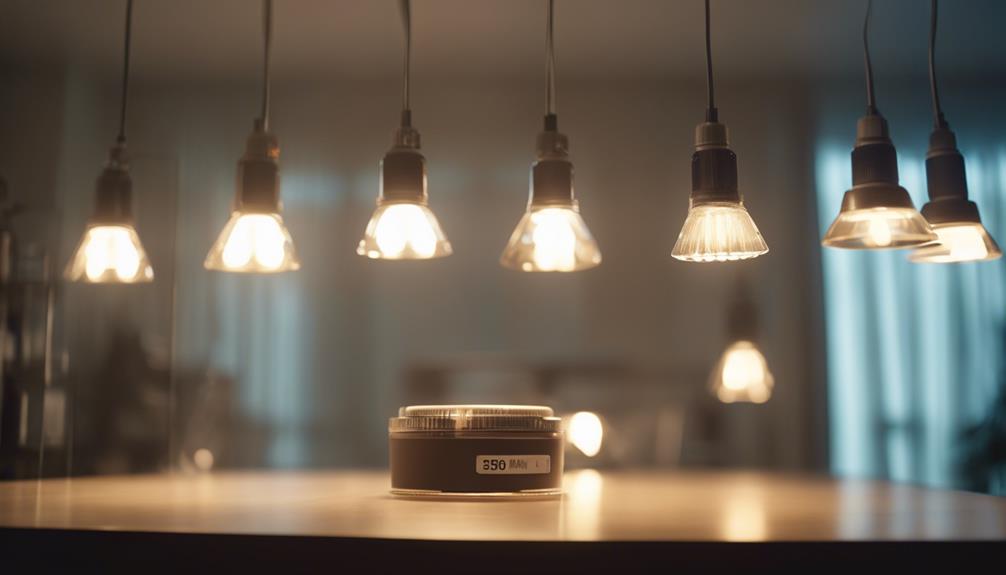
To prevent circuit overloading when using LED lighting, it's important to adhere to the recommended maximum wattage capacity for the lights connected. Exceeding this capacity can lead to overheating and potentially dangerous situations.
It's essential to check the amp rating of your circuit to make sure it can handle the total wattage of all LED lights connected. Distributing LED lights across different circuits can help prevent overloading a single circuit, spreading the electrical load more evenly.
Consider using dimmer switches to control the brightness of LED lights and reduce power consumption, which can also help prevent overloading circuits. Regularly inspecting and maintaining your electrical system is necessary to prevent circuit overloading and ensure safe LED lighting usage.
Follow Manufacturer Hanging Guidelines
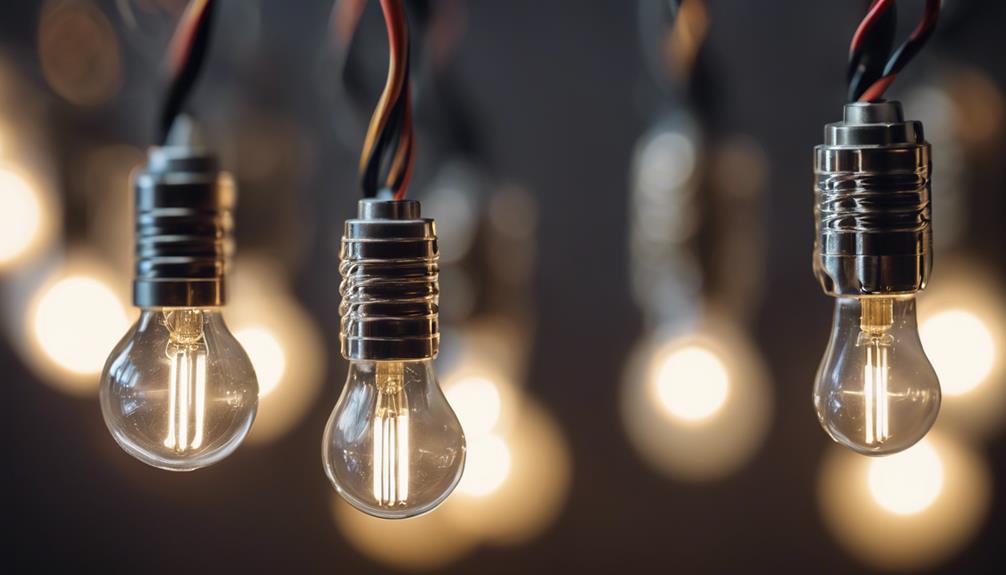
When hanging outdoor string lights, it's important to follow the manufacturer's guidelines for proper fixture installation. Checking the weight capacity and using secure attachment methods are key points emphasized in these guidelines to guarantee safety and prevent accidents.
Proper Fixture Installation
Following the manufacturer's hanging guidelines is essential for ensuring the proper installation of LED fixtures. It's vital to adhere to these instructions to prevent damage to the fixtures, reduce the risk of electrical issues, and enhance the longevity and performance of the lights. Properly hung fixtures not only contribute to safety but also maximize the effectiveness of the lighting.
When installing LED fixtures, consider the following:
- Secure Mounting: Make sure the fixture is securely mounted according to the manufacturer's recommendations.
- Proper Wiring: Follow the specified wiring instructions to avoid electrical problems.
- Correct Positioning: Position the fixture correctly for the best lighting coverage and safety.
Check Weight Capacity
Verifying the weight capacity at the hanging location is vital to prevent overloading the LED fixture. Exceeding the weight limit can lead to damage to the lighting fixture and create potential safety hazards. It's essential to adhere to the manufacturer's guidelines for hanging the fixtures safely and securely.
Failure to follow weight capacity instructions can result in the lights falling, posing a risk of injury or property damage. By ensuring that the weight limits are respected and the fixtures are properly installed based on the manufacturer's recommendations, the longevity and safety of the LED lighting installation can be guaranteed.
Always prioritize safety by checking weight capacity and following hanging guidelines to maintain a secure lighting setup.
Secure Attachment Methods
To guarantee the secure attachment of LED lights, always adhere strictly to the hanging guidelines provided by the manufacturer. Proper installation methods are essential in preventing lights from falling and causing accidents. Here are three essential tips to ensure secure attachment:
- Use the recommended hardware: Follow the manufacturer's instructions on the type of hooks, screws, or brackets that should be used for hanging the LED lights.
- Check weight limits: Make sure that the chosen attachment method can support the weight of the LED lights to avoid any potential hazards.
- Secure wiring: Properly secure the wiring along with the attachment to prevent any accidental disconnection or damage.
Avoid Submerging in Water

Submerging LED lights in water poses serious risks to both the lights and individuals due to the lack of waterproof design. LED lights aren't intended to be waterproof, and exposing them to water can result in electrical hazards and damage to the fixtures. Water exposure increases the likelihood of short circuits, electrical shocks, and potential fire hazards with LED lights.
To guarantee safe and proper functioning, it's vital to keep LED lights dry and away from any sources of moisture. Following manufacturer guidelines for outdoor LED light usage is imperative in preventing water-related accidents and maintaining safety standards.
All-Weather LED Lights

All-weather LED lights are categorized with specific ratings such as dry, damp, and wet to indicate their suitability for various outdoor conditions. When it comes to outdoor LED lights, understanding these ratings is vital for guaranteeing safe usage in different environments.
- Dry-rated LED Lights: These lights are suitable for indoor use only and shouldn't be exposed to any moisture or water.
- Damp-rated LED Lights: Designed to handle indirect water exposure, these lights are perfect for covered outdoor areas like porches or patios.
- Wet-rated LED Lights: Built to withstand direct water exposure, these lights are ideal for open outdoor spaces such as gardens or patios where they may come into contact with rain or irrigation systems.
It's essential to always use LED lights with the appropriate rating for the outdoor environment to prevent electrical malfunctions and ensure safety for everyone enjoying the outdoor spaces.
Manage Outdoor Light Duration
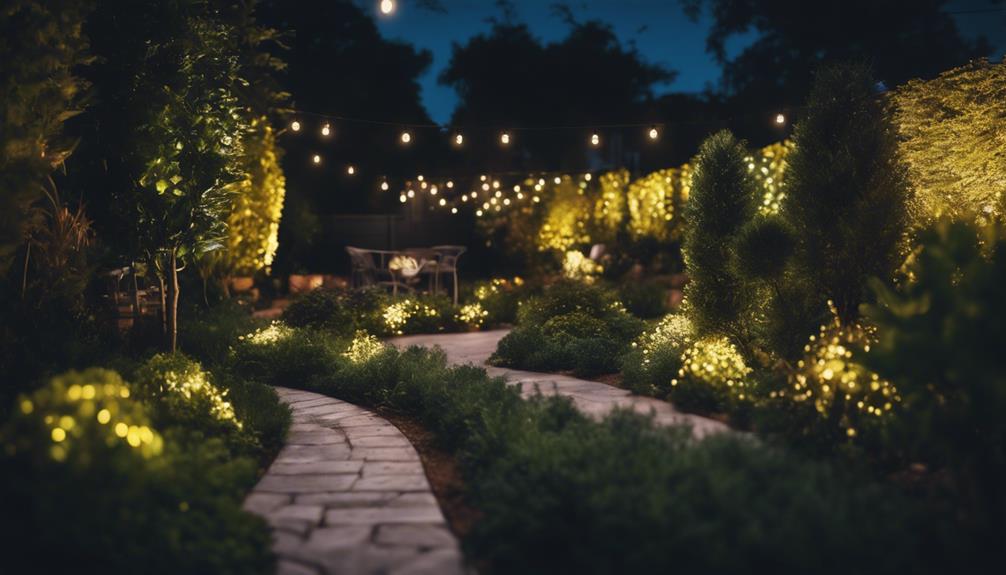
Limiting the duration of outdoor light usage to 8-12 hours per day is essential for conserving energy and extending the lifespan of LED bulbs. LED strip lights are energy-efficient options, but they still require moderation in usage to maximize their benefits.
By using outdoor lights for shorter periods, individuals can greatly reduce energy consumption, leading to lower electricity bills and decreased environmental impact. Overusing outdoor lights not only wastes energy but also accelerates the need for more frequent bulb replacements, ultimately costing more money in the long run.
Managing outdoor light duration is a simple yet effective way to promote eco-friendly practices and save on maintenance expenses. By following the recommended 8-12 hour usage guideline, individuals can enjoy the benefits of LED lighting while ensuring that they use less energy and contribute to a more sustainable environment.
Frequently Asked Questions
What Are the Safety Precautions for LED Lights?
When using LED lights, it's important to follow safety precautions. Check for proper installation and voltage matching. Regularly inspect fixtures for damage to prevent hazards.
LEDs emit less heat, reducing fire risks, and don't contain mercury, making disposal safe. Their resistance to shocks and vibrations makes them versatile.
Being mindful of these factors guarantees safe usage of LED lighting.
How to Safely Use LED Lights?
To safely use LED lights, ensure proper placement, voltage compatibility, and turn off power before bulb replacement.
LED lights emit less heat and don't contain mercury, reducing fire risks and environmental harm.
With a lifespan of 30,000 to 50,000 hours, they require fewer replacements.
What Are the Safety Standards for LED Lighting?
Safety standards for LED lighting are established by organizations like UL and ANSI to guarantee performance, durability, and user safety. Compliance with these standards assures reliability and efficiency while minimizing risks.
Tests cover electrical safety, thermal performance, and durability in various conditions. Following these standards prevents accidents, electrical hazards, and promotes high-quality LED products in the market.
What Are the Safety Rules for Lighting?
Safety rules for lighting involve proper installation, usage, and maintenance to prevent accidents and hazards. Ensuring fixtures are secure, using appropriate wattage bulbs, and avoiding overloading circuits are essential.
Regularly checking for exposed wires, frayed cords, and using surge protectors can enhance safety. Following manufacturer guidelines, keeping flammable materials away from lights, and turning off fixtures when not in use are key practices for a secure lighting environment.
Conclusion
To sum up, remember to always prioritize safety when using LED lighting outdoors. Despite their efficiency and durability, these lights can still pose risks if not used properly.
By following the top 10 safety tips outlined in this article, you can enjoy your outdoor LED lights without any unexpected mishaps.
Stay informed, stay cautious, and illuminate your outdoor space with peace of mind. Safety first, light second!




